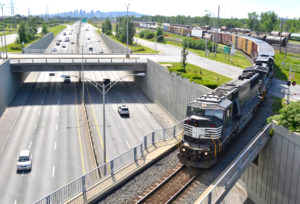
When comparing energy footprints of various transport methods, one needs to consider the circumstances it will be used for. We will look at the factors that make up distribution network for wholesalers and retailers, to ascertain what type of system will best serve their needs.
A number that freight carriers offer for shipping cargo along rail is they can move 1 ton of cargo, over 400 miles using 1 gallon of diesel fuel. This figure will vary according to carrier, elevation changes, total load, among other factors, however it has been proven that trains are far more efficient than transporting cargo using a truck.
The Rail network can cover a large portion of the land, although the large distance between the infrastructure and distribution points decreases the efficiency given the additional transport step. This also reduces the likelihood of alternate routes being available if there are delays along the network. For this reason it will require a significantly larger amount of planning to organize the freight schedule.

Traditionally bulk items (minerals, grains, etc.) are transported using a train network. The rail route is optimized to meet with the loading points of these industries and connect with refining and manufacturing depots. Enabling transportation of the bulk items closer to these points significantly increases the efficiency.
Rail networks are less likely to suffer any delays from adverse weather. They will generally know the schedule of other carriers sharing the route, barring irregular unforeseen delays, they will be able to keep their schedule to improve efficiency.
Transporting goods over road will have a much smaller capacity per vehicle, but the extent to where the distribution network can reach is far superior to using rail. The abundance of vehicles on the road also makes scheduling much more accommodating to freight carriers needs.
When looking at direct comparisons, companies can optimize their distribution network to suit the train system and reduce the energy footprint, unlike retail centers that are governed by consumer demand. If distances for road transportation to retail centers can be kept to a minimum, this will ensure a better energy footprint for the whole network.
Energy used for construction and maintenance of roads is shared between many more thousands of vehicles when compared to rail. This leads to a smaller contribution to the footprint for frequently used roads. The benefits are significantly reduced when accounting for more than the total distribution network that include roads not used for freight transport. The US has a total length of 160,141 miles of rail while the road network exceeds 6.58 million miles.
These factors alone may not guide companies decisions, rather they should ascertain which overall solution is best. Moving a manufacturing plant to an area that uses 100 percent renewable energy will most likely have a much cleaner energy footprint than one with train services that rely on coal for powering their plants.
Using an optimized solution that focuses on intermodal transportation is the better way to minimize the energy footprint. Distribution network of bulk goods should be planned around train networks while retail distribution networks are best serviced optimizing between both rail and road to meet consumer demand.

